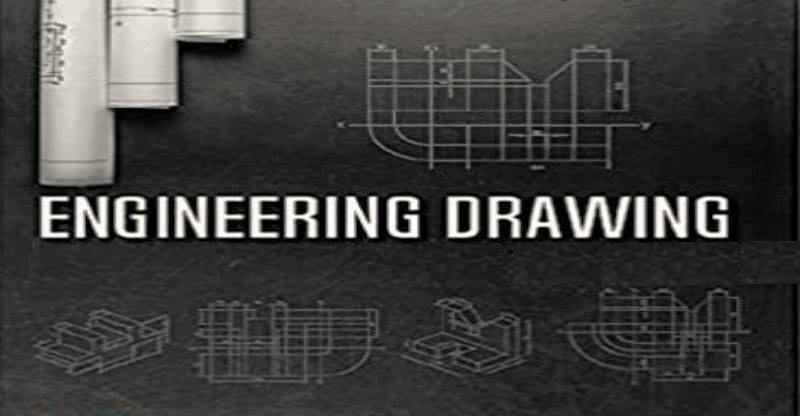DRAWING INSTRUMENTS – Their standard and uses
The following are the commonly used Drawing Instrument(s) in a drawing office.
LARGE COMPASS:

It is one of the drawing instrument(s) which has a knee joint in one leg that permits the insertion of pen or pencil point or attaching lengthening bar with pen or pencil point attached to it. It is used for drawing large circles/arcs also for taking large measurements. The pin on the other leg can be swiveled to vertical position when drawing large circles, while drawing the circles of arcs it should be held in such a way that the needle point leg and pencil point leg should be bent so as to make perpendicular to the paper.
As a rule while drawing concentric circles, small circles should be drawn first before the centre hole gets worn.
LARGE DIVIDER:

It is one of the drawing instrument(s) which is used to transfer dimensions and dividing lines into a number of equal parts. Divider with adjustable joints is preferable rather than plain legs.
BOW INSTRUMENTS:
Bow pencil and bow pen compass are used for drawing circles of approximately 25 mm radius. Bow divider is used for marking or dividing smaller spaces.
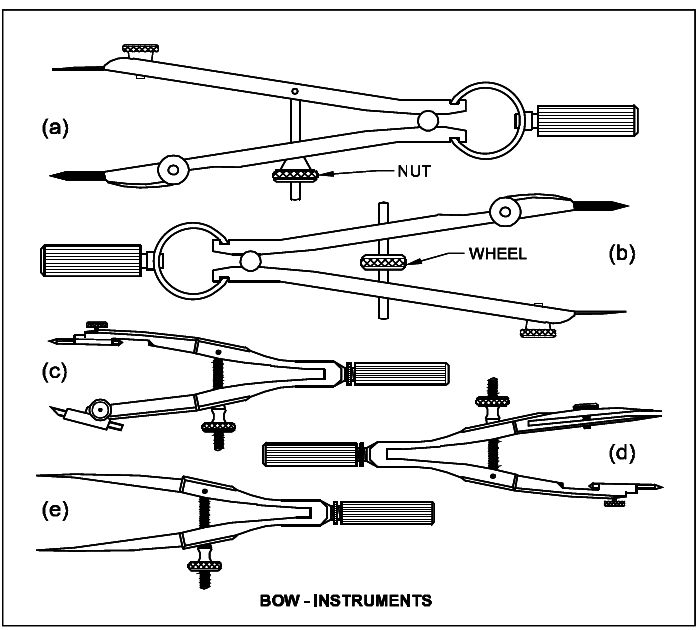
There are two types
(i) Integral legs with spring action
(ii) two legs held with a curved spring on top with handle on it.
Bow instruments may have adjusting wheel and nut. To draw circles, it is better to mark the required distance separately and set the instruments and check. Then only the circles or arcs should be drawn on the drawing. Adjustment should be made with the thumb and middle finger. The instrument is manipulated by twisting the knurled head between the thumb and finger.
DROP SPRING BOW PENCIL AND PEN:
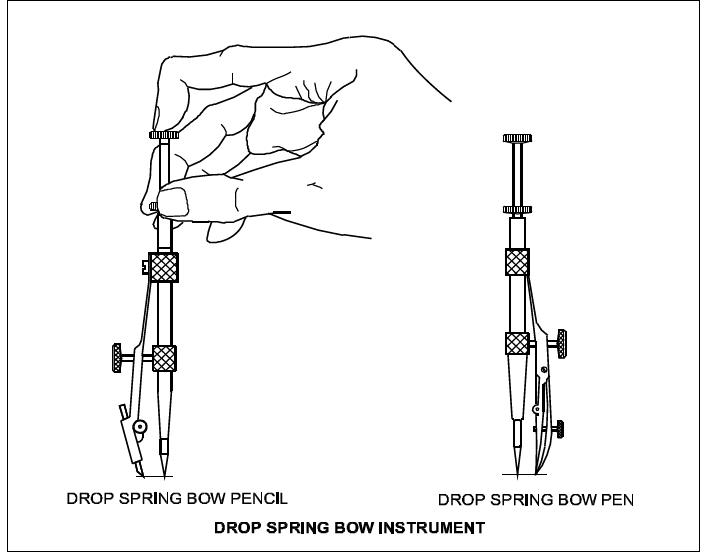
Drop spring bow pencil and pen are designed for drawing multiple identical small circles. Example: rivet holes, drilled/reamed holes. The central pin is made to move freely up and down through the tube attached to the pen or pencil unit. It is used by holding the knurled head of the tube between thumb and middle finger while the index finger is placed on the top of the pin. The pin point is placed on the centre point of the circle to be drawn and pencil or pen is lowered until it touches paper. The instrument is turned clockwise and the circle is drawn.
INKING PEN OR LINER OR RULING PEN:
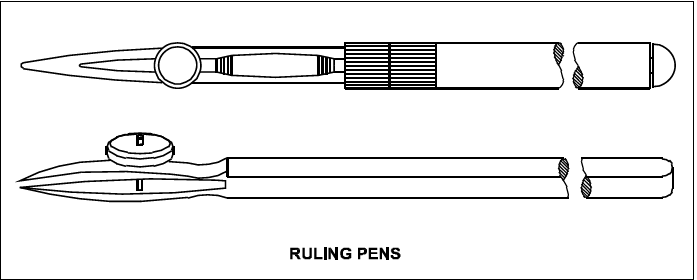
It is one of the drawing instrument(s) which is used to ink the straight lines drawn with the instruments but never for free hand lines or lettering.
LENGTHENING BAR:
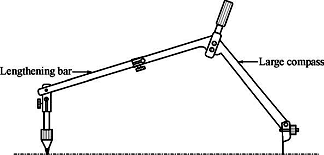
To draw larger circles, it is fitted to the compass. The pencil point or pen point is inserted to its end.
PIN, CLIP, CELLO TAPE:
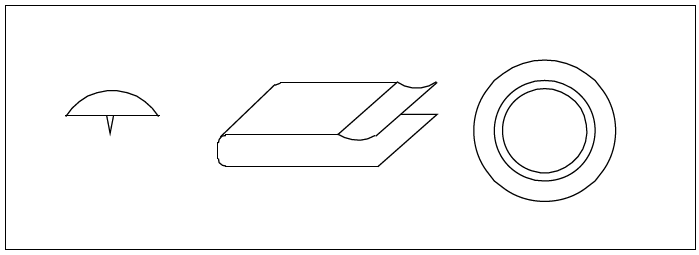
Drawing sheet should be fastened on to the drawing board firmly on temporary basis so that it does not shake during preparing drawing. For this purpose the pins, clips and cello tapes are used.
PENCILS, GRADE AND SELECTION
PENCILS:
In drawing office, standard pencils (lead encased in wood) and semi-automatic pencils are made use. Pencil leads are made of graphite with kaoline (clay) of varying proportion to get the desired grades. More the kaoline higher the hardness.
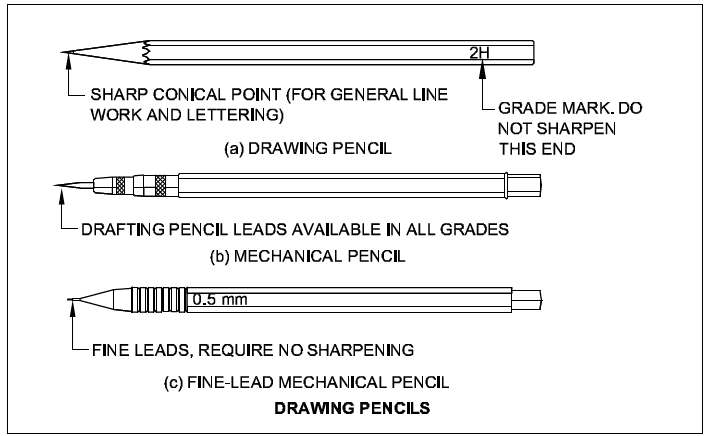
GRADES OF PENCILS:
Pencils are graded according to the hardness or softness of the lead.
Hardest pencil is 9H grade and softest pencil is 7B grade. Selection of grade of pencils depends on the type of line work required and paper on which it is used.
Softer lead pencils are used to produce thicker and darker line work, but they wear out quickly. Medium grade of H, 2H are used for general line work as well as for lettering.
Harder grade leads produce lighter and thinner lines. Most construction line work is done with 4H, 5H and 6H pencil leads, producing thin but also sufficiently dark by exerting pressure. Depending upon the individuals touch and the style of writing, right pencil may be selected.
For any drawing on drawing paper or tracing paper, lines should be black, particularly drawings which are to be reproduced. For this purpose, the pencil chosen must be soft enough to produce jet black lines as well hard enough not to smudge easily. The point should not crumble under normal working pressure. The pencils should not be hard and cut grooves on the paper while drawing with normal pressure, Pencils H, 2H or 3H depending upon the paper (quality) and weather conditions are selected.
In summer the pencil leads become softer due to rise in temperature, so slightly harder pencils can be made use of softer grade pencils are used on smooth surfaces for lettering and arrow head. During rainy season or when humidity is more, the drawing paper expands and wrinkles form, pencil leads become harder. So softer pencils are to be used. Whatever may be grade of pencil you use, always prefer quality pencils/leads viz., Venus, Kohinoor, Apsara etc.
For better line work, i.e., dense black lines, prefer paper which is not having too much teeth (roughness).
SELECTION OF PENCILS:
Pencil grades vary from one brand to another brand. Select the grades of the pencil depending upon the type of line work. For construction lines, you can choose 2H or 3H, for lettering and object lines grade H pencils. In general H, HB and 2H are used.
H medium hard
HB medium soft
2H hard
Pencils used for drawing are always hexagonal in cross sections as they do not roll easily even when they are placed on slope surfaces. Its cross section helps in rotating the pencil, while drawing lines, to give uniform line thickness.
Now-a-days automatic (Mechanical) pencils or clutch pencils are available in different sizes (lead diameter 0.3, 0.5, 0.7 or 0.9 mm). They are easy to handle as there is no reduction of holding length pencil leads can be replaced, as per required grade of hardness. They produce lines of uniform width without sharpening.
RELATED VIDEOS:
